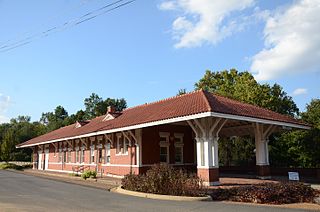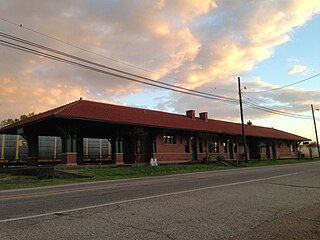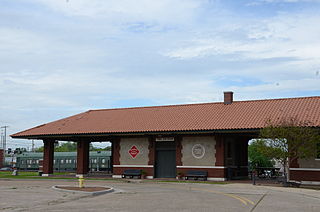
Wheaton is a city in Wheaton Township, Barry County, Missouri, United States. The population was 696 at the 2010 census.

Texarkana Union Station is a historic train station in the Texarkana metropolitan area serving Amtrak, the United States' national passenger rail system. The Arkansas-Texas border bisects the structure; the eastern part, including the waiting room and ticket office, are in Texarkana, Arkansas, but the western part is in Texarkana, Texas, meaning stopped trains span both states. The station was built in 1928 and was added to the U.S. National Register of Historic Places in 1978. Today it is the second busiest Amtrak station in Arkansas.

Marianna Missouri Pacific Depot is a historic railroad station at Carolina and Jarrett Streets in Marianna, Arkansas. It is a long rectangular brick building, with a tile roof. A projection on the track side for the telegrapher's booth is matched by a projection on the opposite side. The depot was built in 1915 by the Missouri Pacific Railroad during a major expansion campaign throughout the state, to provide passenger and freight services to the city.

U.S. Highway 71 is a U.S. highway that runs from Krotz Springs, LA to the Fort Frances–International Falls International Bridge at the Canadian border. In Arkansas, the highway runs from the Louisiana state line near Doddridge to the Missouri state line near Bella Vista. In Texarkana, the highway runs along State Line Avenue with US 59 and partially runs in Texas. Other areas served by the highway include Fort Smith and Northwest Arkansas.

The former Missouri-Pacific Railroad Depot in Camden, Arkansas, is located at the southwest corner of Adams Street and Stadium Drive in the city's business district. It is a single-story brick building with Mediterranean Revival styling built c. 1917 during a major expansion of the Missouri-Pacific Railroad.

The Missouri Pacific Depot of Prescott, Arkansas, United States, is located at 300 West 1st Street North. It is a 1+1⁄2-story red brick building, with a breezeway dividing it into two sections. One section continues to be reserved for railroad storage, while the other, the former passenger ticketing and waiting area, has been adapted for use by the local chamber of commerce and as a local history museum. It was built in 1911-12 by the Prescott and Northwestern Railroad, which interconnected with the Missouri-Pacific Railroad at Prescott. The line had passenger service until 1945.

The Missouri-Pacific Railroad Depot-Gurdon is a historic railroad station building at North 1st Street and East Walnut Street in Gurdon, Arkansas. The single-story masonry building was built c. 1917 by the Missouri-Pacific Railroad to house passenger and freight service facilities. It is built in the Mediterranean Renaissance style which was then popular for building such structures in Arkansas. It has a red clay tile roof, Italianate bracketing, and Baroque quoin molding.

The Missouri Pacific Depot in Earle, Arkansas, is located south of Main Street and west of Commerce Street, on the north side of the Missouri-Pacific Railroad tracks in the center of town. Completed in 1922, this brick single-story depot exhibits architectural features common to those built by the railroad in that period, with extended eaves supported by large brackets. The station was designed to support passenger and small freight traffic, and served the railroad until 1969.
The Missouri Pacific Railroad Depot is a historic train station building on Old Arkansas Highway 9 in the hamlet of Sylamore, Arkansas. It is a rectangular wood-frame structure, covered with a hip roof, that has a projecting telegrapher's bay on one of its long sides. The building is located about 150 feet (46 m) east of the railroad tracks, having been moved to this location c. 1975 from its original site, about 850 feet (260 m) further south and closer to the line. Built c. 1902 when the railroad was built through the area, it served as a passenger depot until service was ended in 1960.
The Missouri and North Arkansas Depot is a historic railroad station at Center Street and Cash Streets in Bellefonte, Arkansas. It is a small single-story structure with a wide low-pitch gable-on-hip roof and a rubble-stone exterior over a wood frame. A small shed-roof addition enlarges the building slightly to the north, while a larger cross-gable addition projects from the rear. It was built in 1901 by the Missouri and North Arkansas Railroad to serve the area's passenger traffic. It is a rare example of rubble-over-frame construction for railroad stations in the region.

The Newport station, also known as Missouri-Pacific Depot-Newport, is a historic railroad station at Walnut and Front Streets in Newport, Arkansas. It is a long rectangular single-story brick and stucco topped by a hip roof, whose wide eaves are supported by large Italianate knee brackets. Its roof, originally slate, is now shingled, detracting from its original Mediterranean styling. A telegrapher's bay extends above the roof line on the track side of the building. The building was built in 1904 by the Missouri-Pacific Railroad to handle passenger and freight traffic.

The Missouri and North Arkansas Depot-Leslie is a historic railroad station at the end of Walnut Street in Leslie, Arkansas. It is a long rectangular single-story building, with stone walls and a bellcast hip roof with extended eaves. A telegrapher's bay projects from the southwest side. It was built c. 1925, and is a surviving representative of the economic success brought to the community with the arrival of the railroad in 1903.

The St. Joe Missouri and North Arkansas Railroad Depot is a historic railroad station on the south side of United States Route 65 in the center of St. Joe, Arkansas. It is a typical long rectangular building, with a gable-on-hip roof, and a telegrapher's booth projecting out the north side. Built in about 1912 by the Missouri and North Arkansas Railroad, it is the only one of that railroad's wood-frame depots to survive in the state, and is the only railroad depot in Searcy County in its original location. The town of St. Joe was incorporated in 1902 as a railroad town.

The Missouri-Pacific Depot, Altus is a historic railroad station on United States Route 64 in Altus, Arkansas. It is a long rectangular single-story wood-frame structure, finished in stucco, with a gable-on-hip roof with broad eaves. It was built in 1920 by the Missouri-Pacific Railroad, and served as both a passenger and freight depot. It is representative of the town's early history as a railroad town.

The Missouri-Pacific Depot, Ozark, now the Ozark Area Depot Museum, is a historic railroad station and museum at 1st and River Streets in Ozark, Arkansas. It is a roughly rectangular stone structure with a hip roof, standing between River Street and the railroad tracks. On its southern (rail-facing) side a telegrapher's booth projects. The roof has broad eaves extending around the building, supported by large Craftsman-style knee braces, and with exposed rafters visible. The station was built in 1910 by the Missouri-Pacific Railroad, and is notable for its association with the economically important railroad, and for its fine Craftsman architecture. It is now a local history museum.

The Missouri Pacific Railway Caboose No. 928 is a historic caboose, located near Market and Vine Streets in Bald Knob, Arkansas, near the former Missouri Pacific Depot. It is a cupola caboose, measuring 34 feet 2 inches (10.41 m) in length and 10 feet 0.5 inches (3.061 m) in width, with a height of 14 feet 8.125 inches (4.47358 m). It was built in 1937 by the Magor Car Corporation, and was used by the Missouri Pacific Railroad until it was retired in 1986. It was one of the first generation of steel-framed cupola cabooses built, a form that later became commonplace. It was then given to the city of Searcy, where it was displayed until 2009. It was transferred to the White County Historical Society, and was then moved to Bald Knob.

The Middle Fork of the Little Red River Bridge, also known as the Shirley Railroad Bridge, is a historic bridge in Shirley, Arkansas. It is a single-span iron Baltimore through truss, with a main span 153 feet (47 m) long, and steel beam approach spans giving it a total length of 339 feet (103 m). The main span rests on large concrete piers set in the river. The bridge was built in 1908 for the Missouri and North Arkansas Railroad, and carried the railroad until 1949. In 1978 the tracks were covered by a concrete deck, and the bridge was converted to single-lane vehicular road use, carrying County Road 125.

The Russellville, Arkansas Missouri Pacific Depot is a historic passenger railroad station located just north of the intersection of South Denver Avenue and West C Street. It is a long rectangular single-story masonry building, finished in brick and stucco and covered by a hip roof with supporting Italianate brackets, designed in a Mediterranean style that was popular when it was built. At both ends, the roof extends beyond the structure to form a sheltered porch supported by square brick columns. A telegrapher's booth projects from the building's north (track-facing) side. An open breezeway separates the passenger and express freight sections of the depot. Three brick chimneys rise through the ridge line, two above the passenger section to the east and one above the freight section to the west. Completed in February 1917, it is typical of many railroad depots of that period; its original tile roof has been replaced by composition shingles.
E. M. Tucker was an American architect of St. Louis, Missouri, who worked for the Missouri Pacific Railroad.

The Fremont, Elkhorn & Missouri Valley Railroad Passenger Depot, also known as the Chicago and North Western Railway Passenger Depot and presently as the Douglas Railroad Interpretive Center, was built in 1886 in Douglas, Wyoming to accommodate traffic on the Fremont, Elkhorn and Missouri Valley Railroad's (FE&MV) terminus at the newly built town. The depot was built as a fairly small, cautious investment in a possibly ephemeral frontier town. Immediately following the completion of the depot Douglas saw an epidemic of typhoid fever and the worst winter in a generation, and the railroad decided to push on to Casper for its terminus. The town's population declined from 1600 in 1886 to 900 in 1888. By 1891 Owen Wister reported that Douglas had a population of about 350. However, by 1910 Douglas had 2246 residents and hosted the Wyoming State Fair. The presence of the fair stimulated rail traffic, while the FE&MV merged with the Cheyenne and Northern Railway in 1903. In 1905 oil development started. In the 1950s coal mining began for the Dave Johnson Power Plant and the railway expanded its Douglas facilities to accommodate the traffic, closing the original depot and building a larger facility. The depot was acquired from the railroad's successor, the Chicago and North Western Railway, by the city in 1990.




















